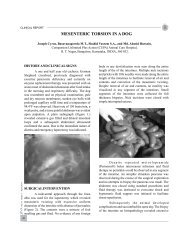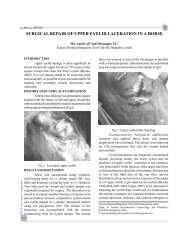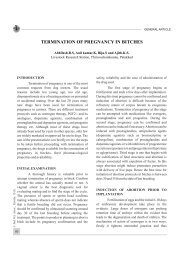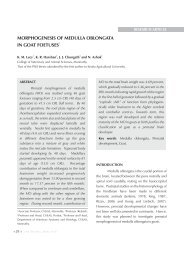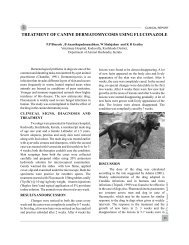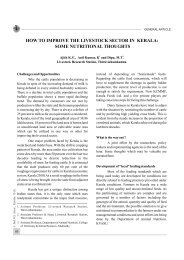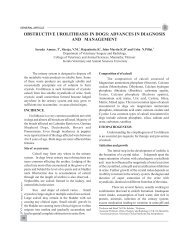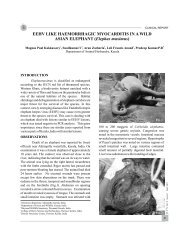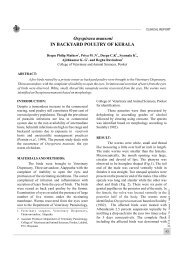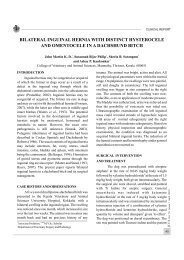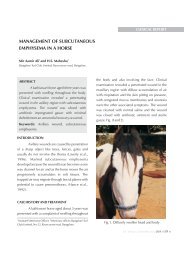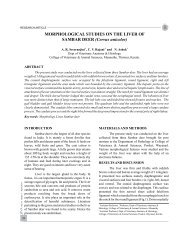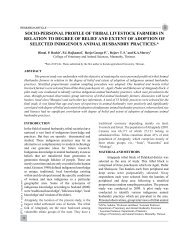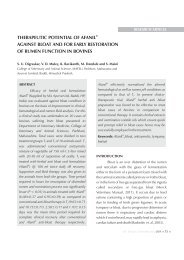2012 Jiva April Cover 220 GSM Art Card Glossy ... - Jivaonline.net
2012 Jiva April Cover 220 GSM Art Card Glossy ... - Jivaonline.net
2012 Jiva April Cover 220 GSM Art Card Glossy ... - Jivaonline.net
You also want an ePaper? Increase the reach of your titles
YUMPU automatically turns print PDFs into web optimized ePapers that Google loves.
GENERAL ARTICLEPrecision Feeding and Total Mixed Ration (TMR)conceptConsidering the cost of production involved,farmers are very conscious of increasing theproductivity of their animals. Considering thedeficiency of fodder and the increasing price of feedingredients, it is possible to go for precision feedingand one such method is total mixed ration. Totalmixed ration is a concept of delivering nutrients toanimals as a complete balanced ration. Total mixedration consists of concentrate, roughage andmicronutrients / feed additives. The concentrate androughage are added in different levels, according tothe stage of lactation and physiological stage of theanimal. Roughage part is generally crop residue orhay. The concentrate portion includes oilcakes,molasses, grains or grain byproducts. Bypassproteins or bypass fat can also be added depending onthe requirement of the animal. Micro nutrients,vitamins, trace minerals, binders, probiotics,antioxidants, antitoxins and herbal extracts are alsoincluded to promote proper body function. Theseingredients are made into blocks using hydraulicpress and as a result of densification process theconcentrate matter get attached to the roughage alongwith molasses which facilitates the cellulolyticmicrobes to grow faster and enhance cellulolyticactivity in rumen.(Walli,T.K. 2010)Advantages of Total Mixed Ration It is the best way to feed balanced ration toruminants. Less feed wastage. Saves time and labor. Easy for transportation and storage. Crop residues can be effectively utilized Reduces methane production. Improved productive and reproductiveefficiency.Use of Agricultural or Industrial byproducts ornovel feedsDuring 2009-10, the price of cow milk hasincreased only by 6 percent in Kerala. On the inputside, the price of grass, gingelly oil cake, coconut oilcake and ground nut cake recorded an increase of 20percent, 12 percent, 3 percent and 12.5 percentrespectively during 2009-10. The increased cost ofinputs is a serious threat affecting profitability ofdairy farming. Since feed cost accounts to about 70percent of the cost of the livestock farming, researchshould be focused on measures to reduce the cost offeeding. Researches on nutritional and possibleinclusion of tapioca leaves, tapioca starch waste,rubber seed, coffee husk, neem seed, coconut pith,plantain rhizome, cashew apple waste, pepper waste,African payal, palm leaves, frog meal, prawn waste,jack fruit waste, cocoa pods, etc in cattle feed hadbeen undertaken at the Department of Animalnutrition, Kerala Veterinary And Animal SciencesUniversity. These results should be popularizedamong farmers and the farmers should beencouraged to produce of low cost feed using thelocally available feed resources at their door steps.Agricultural by products and crop residues which areavailable in plenty can be effectively utilized eitherby physical treatment (chopping of straw or watersoaking), chemical treatment (Urea treatment ofstraw) or by biological treatment (using fungi ortreatment with exogenous fibrolytic enzymes).Since there is emergence of more and morehuman food industries, their byproducts can formexcellent substances to be included in cattle feed.Notable examples being brewery waste, pine applewaste, spent ginger, tea waste, flours of breadindustry, etc. Much nutritional studies in this regardhave to be conducted in future.Use of bypass technologyRuminants have advantage over nonruminantsin that they can digest large amount offiber and they can utilize non protein nitrogen.However there are also some constraints as themicrobial nutrients may be insufficient for a higherproducing animal and the concept of bypass protein,bypass fat and by pass starch comes in to picture.Steps have to be taken for educating the farmers forjudicious use of the feed available to them.JIVA Vol. 10 Issue 1 <strong>April</strong> <strong>2012</strong>67



